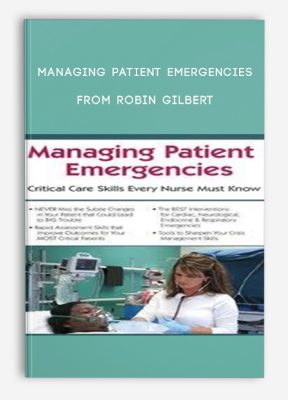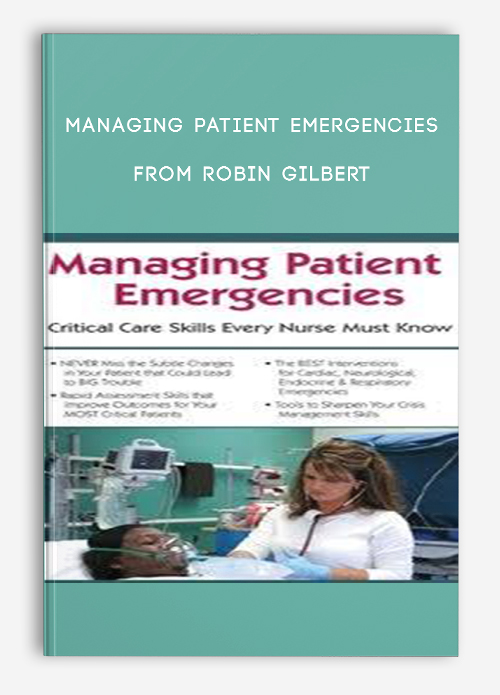Subtotal: $47.00
Managing Patient Emergencies from Robin Gilbert
$219.00 $65.00

Managing Patient Emergencies from Robin Gilbert
Faculty:Robin Gilbert
Duration:Full Day | Format:Audio and Video
Archive : Managing Patient Emergencies from Robin Gilbert
Get Managing Patient Emergencies from Robin Gilbert on Salaedu.com
Outline:
Identifying the RED Flags
- Critical Thinking During a Crisis
- Vital Signs & ABCDs
- Methods for Establishing and Maintaining Airway
- Breathing: More Than a Rate Issue
- Circulation & Perfusion
- Rapid Assessment Techniques
- Critical Questions to Ask Your Patient
- Identifying High-Risk Populations
- Sick or Not Sick…Who would you see first?
Cardiovascular
Prevention, Presentation, Action for: “I’m having chest pain”
- Recognizing Arrhythmias – Stable, Unstable and Lethal
- Rhythm Recognition & Treatment for: VT, VF, SVT, and Heart Blocks
- Acute Myocardial Infarction: STEMI/NSTEMI
- Key Assessments & Interventions
- tPA Guidelines
- Laboratory Parameters
- Recognizing Subtle Changes
- Hemodynamic Monitoring:
- MAP, CO, SV, CI
- Preload, Afterload, Contractility
- Skills Practice: EKG Interpretation
Respiratory
Prevention, Presentation, Action for: “I can’t breathe”
- Capnography Basics
- Assessment & Critical Interventions for:
- Pulmonary Embolism
- Respiratory Failure
- COPD
- ARDS
- The Patient Who Needs Assistance
- O2, CPAP, BiPAP
- Indications for Intubation
- Positive Pressure Ventilation
- Chest Tube Management
- Easy ABG Analysis…Really!
Endocrine
Prevention, Presentation, Action for: “I don’t feel right”
- The Differences of DKA and HHNK
- Early Recognition of Hypoglycemia
- Critical Lab Findings
- Differentiating the Diagnosis – Case Studies
- Which Intervention Should you do FIRST
- What is the Likely Problem
- Anticipating the Solutions
Neurological
Prevention, Presentation and Action for: “My head hurts!”
- Elevated Intracranial Pressure
- Clues When you Don’t have a Monitor
- Ischemic vs. Hemorrhagic Stroke
- Inclusion/Exclusion for tPA
- Critical Labs
- Malignant Headache
- Delirium
- Autonomic Dysreflexia
- Simulation Lab Review
- Interpreting the Patient’s Presentation
Fluid Imbalance/Circulatory Emergencies
- Sepsis
- Shock
- GI Bleed
- Abdominal Aortic Aneurysm
- Compartment Syndrome
Managing the Decompensating Patient
- No Pulse, No Blood Pressure, No Respirations…Now What?
- Common Medications
- Monitor/Defibrillator Review
- Roles & Responsibilities During a Code
What’s New & Trending
- Ethical Considerations
- Documentation Pitfalls
- Staffing Considerations & High Acuity Patients
Get Managing Patient Emergencies from Robin Gilbert on Salaedu.com
Description:
Identifying the RED Flags
- Critical Thinking During a Crisis
- Vital Signs & ABCDs
- Methods for Establishing and Maintaining Airway
- Breathing: More Than a Rate Issue
- Circulation & Perfusion
- Rapid Assessment Techniques
- Critical Questions to Ask Your Patient
- Identifying High-Risk Populations
- Sick or Not Sick…Who would you see first?
Cardiovascular
Prevention, Presentation, Action for: “I’m having chest pain”
- Recognizing Arrhythmias – Stable, Unstable and Lethal
- Rhythm Recognition & Treatment for: VT, VF, SVT, and Heart Blocks
- Acute Myocardial Infarction: STEMI/NSTEMI
- Key Assessments & Interventions
- tPA Guidelines
- Laboratory Parameters
- Recognizing Subtle Changes
- Hemodynamic Monitoring:
- MAP, CO, SV, CI
- Preload, Afterload, Contractility
- Skills Practice: EKG Interpretation
Respiratory
Prevention, Presentation, Action for: “I can’t breathe”
- Capnography Basics
- Assessment & Critical Interventions for:
- Pulmonary Embolism
- Respiratory Failure
- COPD
- ARDS
- The Patient Who Needs Assistance
- O2, CPAP, BiPAP
- Indications for Intubation
- Positive Pressure Ventilation
- Chest Tube Management
- Easy ABG Analysis…Really!
Endocrine
Prevention, Presentation, Action for: “I don’t feel right”
- The Differences of DKA and HHNK
- Early Recognition of Hypoglycemia
- Critical Lab Findings
- Differentiating the Diagnosis – Case Studies
- Which Intervention Should you do FIRST
- What is the Likely Problem
- Anticipating the Solutions
Neurological
Prevention, Presentation and Action for: “My head hurts!”
- Elevated Intracranial Pressure
- Clues When you Don’t have a Monitor
- Ischemic vs. Hemorrhagic Stroke
- Inclusion/Exclusion for tPA
- Critical Labs
- Malignant Headache
- Delirium
- Autonomic Dysreflexia
- Simulation Lab Review
- Interpreting the Patient’s Presentation
Fluid Imbalance/Circulatory Emergencies
- Sepsis
- Shock
- GI Bleed
- Abdominal Aortic Aneurysm
- Compartment Syndrome
Managing the Decompensating Patient
- No Pulse, No Blood Pressure, No Respirations…Now What?
- Common Medications
- Monitor/Defibrillator Review
- Roles & Responsibilities During a Code
What’s New & Trending
- Ethical Considerations
- Documentation Pitfalls
- Staffing Considerations & High Acuity Patients
1 review for Managing Patient Emergencies from Robin Gilbert
Add a review Cancel reply
Related products
HEALTH - FITNESS - LIFESTYLE - MEDICAL
HEALTH - FITNESS - LIFESTYLE - MEDICAL
HEALTH - FITNESS - LIFESTYLE - MEDICAL
HEALTH - FITNESS - LIFESTYLE - MEDICAL
HEALTH - FITNESS - LIFESTYLE - MEDICAL
HEALTH - FITNESS - LIFESTYLE - MEDICAL
HEALTH - FITNESS - LIFESTYLE - MEDICAL

 Amish Shah - The Project 2015
Amish Shah - The Project 2015 








king –
We encourage you to check Content Proof carefully before paying.
“Excepted” these contents: “Online coaching, Software, Facebook group, Skype and Email support from Author.”
If you have enough money and feel good. We encourage you to buy this product from the original Author to get full other “Excepted” contents from them.
Thank you!